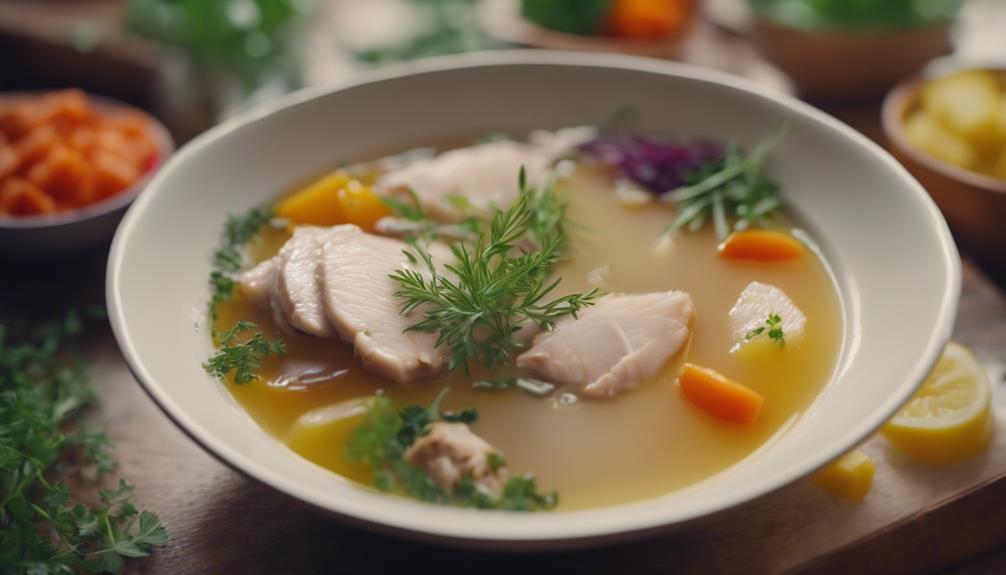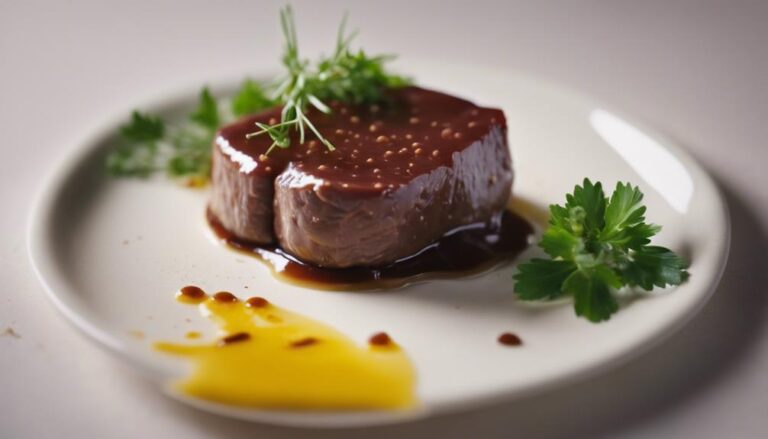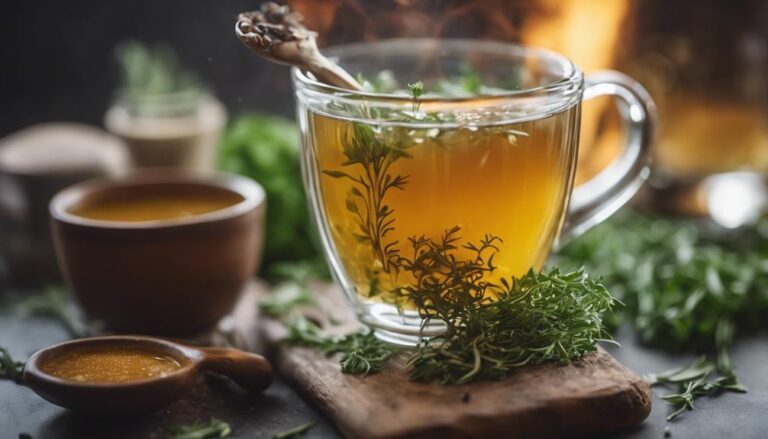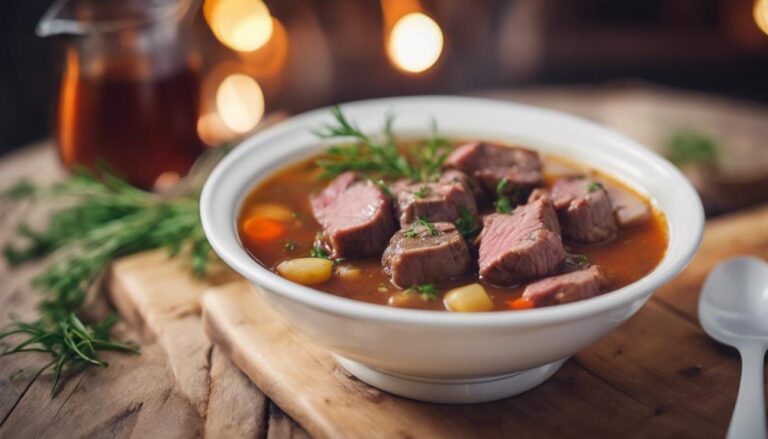Ous Vide Chicken Broth: Warm and Satisfying
Immerse yourself in the inviting warmth and satisfaction of sous vide chicken broth. This delectable elixir, created with precision cooking, offers a rich and comforting experience that will delight your taste buds. The blend of flavors in this broth is meticulously crafted to provide a deeply gratifying sensation, leaving you feeling nourished and content. The precise cooking method employed in sous vide guarantees that every sip is filled with intense, savory goodness. Discover the world of flavor waiting for you in this soul-warming broth.
What You Will Learn Here
- Sous vide method retains maximum flavor and nutrients.
- Slow cooking process ensures rich and intense chicken essence.
- Consistent temperature creates a tender and succulent broth.
- Enhanced depth and complexity of flavors compared to traditional methods.
- Delivers a comforting and deeply satisfying warmth in every spoonful.
Broth's Ancient Origins
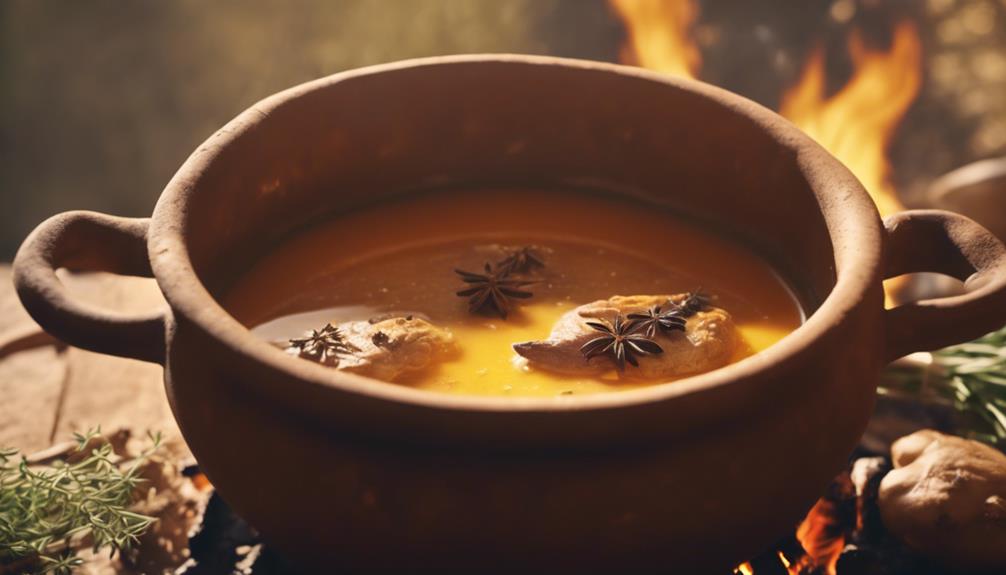
Imagine a time when simmering bones and vegetables over a fire wasn't just about sustenance but a ritual of community and healing.
The historical roots of broth run deep in cultures around the world, with each region infusing its unique flavors and techniques into this timeless elixir.
From ancient times to modern kitchens, the evolution of broth-making reflects humanity's ingenuity and reverence for the nourishing essence of this simple yet profound liquid.
Historical Roots of Broth
Dating back to ancient civilizations, broth has been a cornerstone in culinary traditions worldwide, serving as a foundational element in various cuisines throughout history. Broth preservation techniques were crucial in ensuring food longevity, while historical broth rituals often held spiritual significance, symbolizing nourishment and community. In ancient times, broth was not only valued for its culinary importance but also for its medicinal properties, with many cultures using it as a remedy for ailments, highlighting the significance of broth in medicine. Additionally, broth played a significant role in folklore, with tales of its healing powers passed down through generations. The rich history of broth reflects its enduring presence as a comforting and versatile dish that continues to bring people together.
| Aspect | Description |
|---|---|
| Broth Preservation Techniques | Techniques such as salting, smoking, and boiling were used to preserve broth. |
| Historical Broth Rituals | Rituals surrounding the making and consumption of broth varied across cultures. |
| Broth in Medicine | Broth was believed to possess healing properties and was used in traditional medicine. |
| Broth in Folklore | Folklore often depicted broth as a magical elixir with mystical powers. |
Cultural Significance of Broth
Broth's ancient origins reveal a tapestry of cultural significance woven through centuries of culinary evolution, embodying traditions that transcend mere sustenance to encompass communal bonds and ancestral wisdom.
Culinary traditions around the world have long revered broth for its healing properties, viewing it not just as a meal but as a medicinal elixir passed down through generations. The act of simmering bones and vegetables to create broth is a ritual that speaks to the interconnectedness of food, health, and heritage.
From Asian bone broths believed to boost immunity to European stocks used for their comforting qualities, broth-making reflects a deep-rooted respect for the nourishing power of ingredients. Embrace the historical richness of broth-making, honoring the cultural significance it holds in culinary traditions.
Evolution of Broth-Making
Embarking on a journey through the annals of culinary history reveals the captivating evolution of broth-making, tracing back to ancient practices that intertwined sustenance with cultural traditions and medicinal beliefs.
Broth holds a significant place in the culinary world, with its origins dating back centuries. Ancient civilizations used broth not only as a source of nourishment but also for its purported health benefits.
The art of broth-making has evolved over time, incorporating modern techniques to enhance flavor and nutritional value. Today, broth continues to be a staple in many cuisines worldwide, cherished for its comforting warmth and versatility.
Understanding the historical roots of broth-making allows us to appreciate its enduring appeal and the role it plays in culinary traditions across different cultures.
Key Broth Components
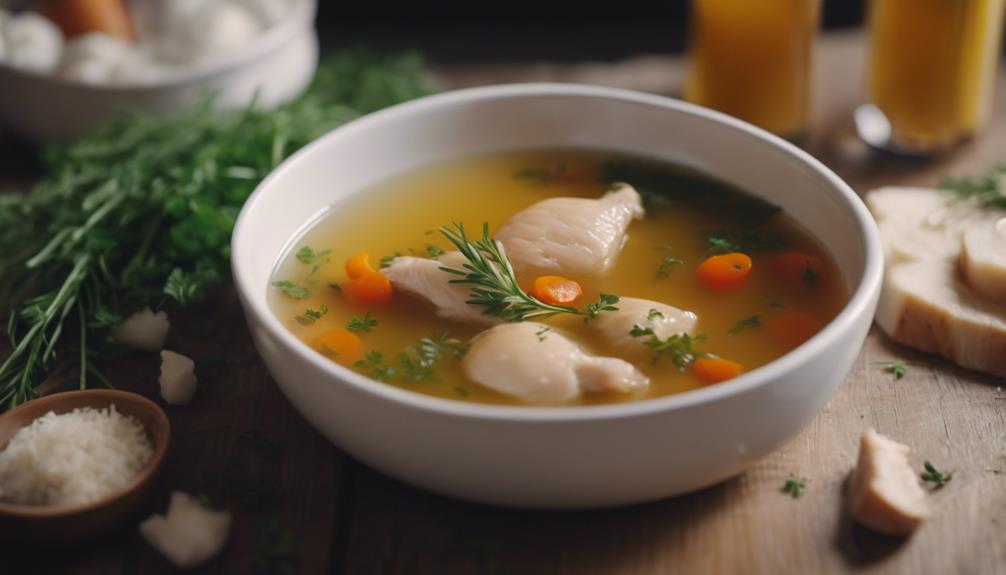
While the flavor of the broth is essential, the key components that define a high-quality chicken broth go beyond just taste. When aiming to create a superior chicken broth, consider these essential elements:
- Nutrient Density: A good broth should be packed with essential nutrients like collagen, gelatin, and amino acids, offering numerous health benefits for the consumer.
- Clarity: The clarity of the broth indicates the quality of the ingredients and the cooking process. A clear broth suggests a well-made and properly strained liquid.
- Balance of Flavors: A harmonious blend of savory, umami, and aromatic notes creates a depth of flavor that elevates the overall taste experience.
- Texture: The mouthfeel of a broth is just as important as its taste. A rich and velvety texture indicates a well-simmered and concentrated broth.
- Aroma: The aroma of the broth should be enticing and comforting, drawing you in even before the first sip.
Broth-Based Noodle Soup
When it comes to broth-based noodle soups, the possibilities are endless. Whether you prefer the classic savory chicken noodle soup, the rich and creamy chicken and mushroom soup, or the hearty chicken vegetable stew, there's a flavor combination to suit every palate.
These comforting and satisfying soups are perfect for cozy nights in or as a pick-me-up when you're feeling under the weather.
Savory Chicken Noodle Soup
For a hearty and comforting meal, simmer the rich sous vide chicken broth with tender noodles and aromatic vegetables to create a soul-warming bowl of savory chicken noodle soup. This homemade goodness is perfect for a cozy night in or when you need a pick-me-up.
Here are five essential elements to perfect your savory chicken noodle soup:
- Tender Chicken: Use succulent shreds or chunks of cooked chicken to add protein and flavor.
- Al dente Noodles: Cook the noodles separately and add them to the broth just before serving to maintain their texture.
- Aromatic Vegetables: Onions, carrots, and celery form the classic mirepoix base for a fragrant broth.
- Herbs and Spices: Enhance the flavors with bay leaves, thyme, and a touch of black pepper.
- Garnish: A sprinkle of fresh parsley or a squeeze of lemon juice can elevate the soup's taste.
Creamy Chicken and Mushroom Soup
Indulge in a velvety blend of tender chicken, earthy mushrooms, and rich broth with this luscious Creamy Chicken and Mushroom Soup. This soul-warming soup offers a creamy texture that hugs your taste buds, while the umami flavor from the mushrooms adds a delightful depth to each spoonful.
Here are some reasons why this soup is a must-try:
- The creamy consistency of the soup creates a luxurious mouthfeel.
- The umami flavor from the mushrooms elevates the overall taste profile.
- The tender chicken pieces provide a hearty and satisfying element.
- The rich broth ties all the ingredients together harmoniously.
- Perfect for a cozy night in or as a comforting meal to share with loved ones.
Hearty Chicken Vegetable Stew
Get ready to savor a comforting bowl of Hearty Chicken Vegetable Stew, a nourishing broth-based noodle soup that promises warmth and satisfaction in every spoonful.
This hearty stew combines tender chicken, vibrant vegetables, and flavorful broth to create a wholesome and fulfilling meal. The aroma of simmering broth paired with the rich flavors of the vegetables will instantly make you feel at home.
Here are five reasons why this dish is a must-try:
- The combination of juicy chicken and fresh vegetables creates a harmonious blend of flavors.
- The use of broth as a base enhances the overall taste and adds depth to the stew.
- The hearty texture of the noodles provides a satisfying and filling element to the dish.
- Cooking techniques like slow simmering allow the flavors to meld together, resulting in a delicious outcome.
- This stew is a perfect option for those seeking comforting meal ideas that are both nutritious and delicious.
Broth-Skimming Technique
When it comes to skimming your chicken broth, mastering the technique can elevate your culinary game.
By removing impurities and excess fat, you enhance the broth's clarity and flavor profile.
Implementing efficient skimming practices and learning some insider tips can make all the difference in achieving a rich and clean broth.
Skimming Benefits Explained
Enhancing the clarity and depth of your broth, the skimming process during cooking is essential for achieving a cleaner and more flavorful end result. Skimming techniques involve carefully removing impurities like foam, fat, and other particles that rise to the surface.
By regularly skimming these unwanted elements, you guarantee that your broth remains clear, light, and free from any off-flavors. This process not only enhances the visual appeal of your broth but also contributes greatly to its taste profile.
Skimming benefits include a purer flavor, improved mouthfeel, and a more professional finish to your dish. Embrace skimming as a fundamental step in the broth-making process, and you'll heighten the overall quality of your culinary creations.
Efficient Skimming Process
For a streamlined and effective broth-skimming technique, focus on gently removing impurities to elevate the clarity and flavor of your chicken broth.
An efficient method involves using skimming tools like a wide spoon or a fine mesh skimmer to skim off any foam or scum that rises to the surface during the cooking process. These tools allow you to delicately remove unwanted particles without disturbing the broth too much.
By skimming regularly and efficiently, you guarantee that your broth remains clear and free of excess fat, resulting in a more refined and flavorful end product.
Embrace the process as a way to enhance the quality of your broth, showing care and attention to detail in every step of its preparation.
Skimming Tips and Tricks
To master the art of skimming for your chicken broth, finesse and precision are key in achieving a broth that's both clear and full of flavor. When it comes to skimming efficiency, time management is essential. Skim the surface of your broth frequently but gently to remove impurities without disturbing the flavorful liquid below.
Utilize skimming tools like a wide spoon or a fine mesh strainer to make the process smoother and more effective. These tools help in easy fat removal, ensuring your broth remains light and aromatic.
Final Thoughts
In conclusion, the depth of flavor and purity of the sous vide chicken broth truly sets it apart from traditional methods. Reflecting on the process, you must have felt a sense of satisfaction knowing that every drop of this warm and comforting broth was carefully crafted to perfection. The rich, savory taste that envelopes your senses with each sip is unparalleled, making it a truly satisfying experience.
As you enjoy a bowl of this soul-warming broth, the comfort it brings can't be overstated. The meticulous preparation and precise cooking method result in a broth that isn't only delicious but also nourishing to both body and soul. The flavors are so pure and intense, providing a deeply satisfying sensation that lingers long after the last sip.
Frequently Asked Questions
Can You Freeze the Chicken Broth for Later Use?
You can freeze the chicken broth for later use. It's a great way to preserve it. Consider portioning it into ice cube trays for easy access. Freezing maintains its flavor and quality for future dishes.
How Long Can Homemade Chicken Broth Be Stored in the Fridge?
When storing homemade chicken broth in the fridge, remember that for extended storage, it's best to use it within 3 to 4 days to maintain quality and freshness. Refrigeration guidelines are important for preserving its taste.
Is It Safe to Reheat Chicken Broth Multiple Times?
Reheating chicken broth multiple times might compromise food safety. It's best to reheat only what you'll consume to avoid flavor loss. Add seasonings like herbs or spices each time for a tasty boost!
Can Different Types of Meat Be Used to Make Broth?
Yes, you can use different types of meat to make broth. Beef broth offers a hearty flavor, while pork broth adds richness. Turkey broth provides a lighter taste, and fish broth brings a unique seafood essence. Experiment to find your favorite!
How Can I Make My Chicken Broth More Flavorful?
To make your chicken broth more flavorful, try seasoning techniques like adding fresh herbs, garlic, and onions. Enhance the taste with flavor enhancers such as soy sauce or fish sauce. Allow the broth to simmer longer for better flavor extraction.
Conclusion
Overall, sous vide chicken broth is a comforting and nourishing staple that has stood the test of time.
With its rich flavor and nutrient-packed ingredients, it's no wonder why this ancient elixir continues to be a beloved favorite.
Whether enjoyed on its own or used as a base for a hearty noodle soup, sous vide chicken broth is sure to warm both body and soul with every sip.
